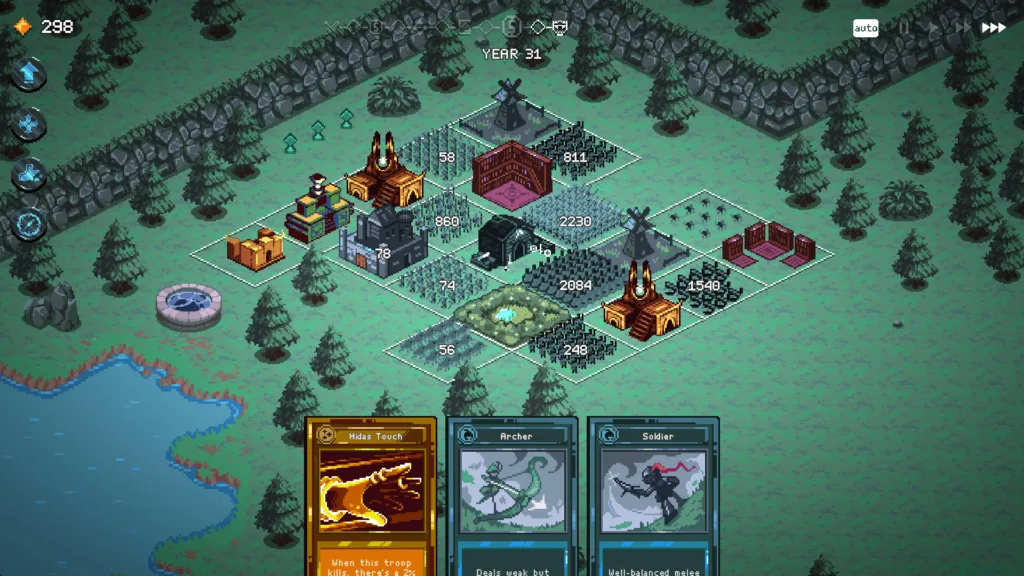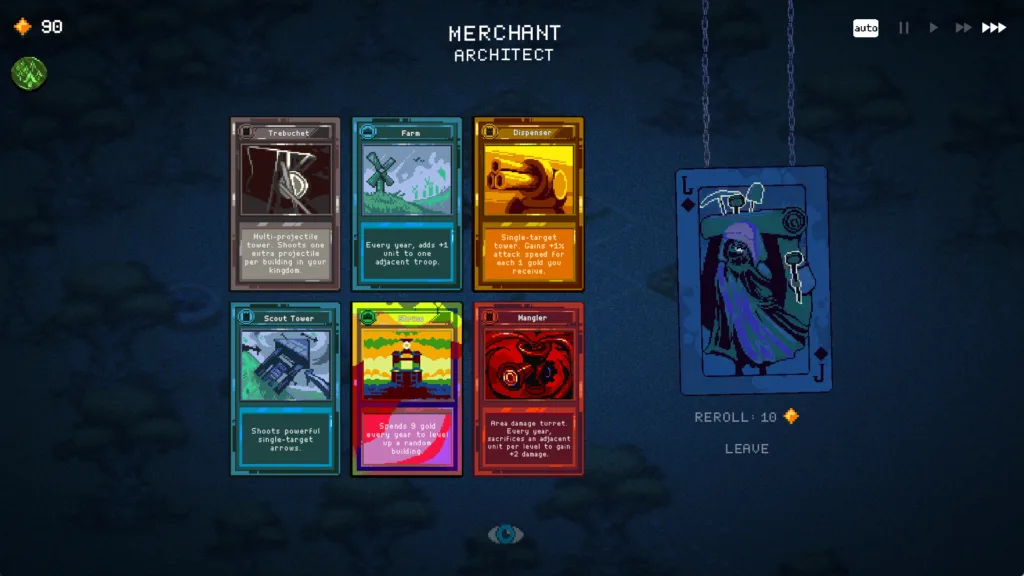Sad Socket’s 9 Kings arrives as a compelling answer to the question of how many mechanical systems one game can successfully juggle. This Early Access roguelike attempts something genuinely ambitious: fusing auto-battler combat with deck-building card mechanics and spatial city-building puzzles. The result feels less like a patchwork of borrowed ideas and more like a natural evolution of the roguelike formula.
At its heart, 9 Kings transforms the traditional roguelike experience into something resembling a rapid-fire kingdom management simulator. Players select from seven available monarchs (with two more promised for full release), each representing a distinct strategic archetype. Your kingdom exists as a modest 3×3 grid where every placement decision carries weight, and each turn represents a full year of rule. The game’s pixel art presentation keeps the visual complexity manageable even as the mechanical depth expands, allowing players to focus on the strategic puzzle rather than parsing cluttered interfaces.
What distinguishes 9 Kings from other genre-blending experiments is its commitment to making each mechanical layer feel essential rather than superfluous. The deck-building elements don’t exist merely to gate content—they create genuine tactical dilemmas about resource allocation and timing. The city-building isn’t just aesthetic window dressing—spatial relationships determine the effectiveness of your entire strategy. This integration suggests a development team that understands how different game systems can reinforce rather than compete with each other.
The Clockwork of Conquest
Each year in 9 Kings presents you with three cards and forces an immediate decision: play one, discard one for gold, or mill one to clear space. This seemingly simple choice cascades into complex strategic considerations that define the entire experience. Buildings might provide adjacency bonuses to neighboring tiles, requiring you to think several turns ahead about optimal placement. Units occupy precious grid space but form the backbone of your defense. Upgrades can transform existing assets but consume valuable card draws.
The spatial puzzle element becomes particularly engaging when you discover synergies between different card types. Place boars next to other units, and those units can mount them for speed and damage bonuses. Position a cemetery adjacent to fragile troops like imps, and watch them resurrect to die again, feeding your demon altars with their repeated sacrifices. These interactions create moments of genuine discovery where mechanical understanding translates directly into strategic advantage.
Combat automation might initially seem like a missed opportunity for player agency, but it serves the game’s broader design philosophy. Battles resolve according to predetermined unit behaviors and targeting priorities, removing micro-management friction while maintaining strategic depth. Your primary intervention comes through each king’s unique castle ability—whether hurling stones, casting lightning, or summoning defensive towers. This limited control keeps battles engaging without overwhelming players with real-time tactical demands.
The diplomatic system adds another layer of strategic consideration by allowing you to influence which enemy factions you face. Since defeating opponents grants you cards from their faction, declaring war becomes about more than just eliminating threats—it’s about curating your card pool to support specific strategies. Want to build a hybrid necromancy-technology army? Target the King of Blood and King of Progress. This system transforms enemy selection from random encounter to strategic choice.
Resource management remains elegantly simple: gold from discarded cards, troop replenishment costs, and the ever-present pressure of your three-life castle. The economy never becomes overly complex, instead serving as a supporting framework for the more intricate spatial and tactical decisions that define each run.
Seven Paths to Power
The genius of 9 Kings lies in how dramatically different each monarch feels to play. This isn’t merely cosmetic variation—each king fundamentally alters your strategic approach and decision-making process. The King of Nothing serves as an accessible entry point with straightforward military units and a simple stone-throwing castle ability, but even this “basic” option offers surprising depth through careful unit positioning and timing.
The King of Blood epitomizes the game’s commitment to thematic coherence. Every card in his arsenal reinforces the necromantic power fantasy: demon altars that grow stronger as your units die, cemeteries that resurrect fallen troops, and imps designed to perish gloriously for the greater evil. Watching your demons literally grow larger on screen as they feast on death creates a visceral connection between mechanical systems and thematic expression.
The King of Nature takes an opposite approach, focusing on sustainable HP-based strategies and healing abilities. His boar-mounting mechanics create fascinating tactical possibilities—suddenly your slow paladins become cavalry charges, or your ballistas gain mobility to become “boarlistas.” These aren’t just stat modifications; they’re strategic transformations that change how units function on the battlefield.
The King of Stone represents perhaps the most radical departure from traditional army-building. His castle ability places defensive towers directly on the battlefield during combat, shifting focus from pre-battle preparation to mid-fight positioning. This tower defense approach requires completely different tactical thinking compared to unit-focused strategies.
Each king’s unlock requirements feel meaningfully connected to their playstyle rather than arbitrary gates. The King of Blood demands 9,999 enemy kills, reinforcing his role as master of carnage. The King of Greed requires significant gold expenditure, emphasizing his materialistic nature. These unlock conditions create natural progression goals while teaching players about each faction’s core identity.
The perk system adds another dimension to king differentiation. With nine unlockable perks per monarch (though players typically can only afford 2-3 in a single run), each king develops additional strategic options over time. Some perks modify starting conditions, others provide mid-run bonuses, and a few fundamentally alter how certain cards function. This system ensures that even familiar kings continue offering new strategic possibilities as you progress.
Challenge and Mastery
9 Kings implements a nine-tier difficulty system that reveals the game’s true strategic depth. Early difficulties allow for experimentation and learning, but around tier six, the game demands genuine mastery of its systems. Enemy scaling becomes aggressive enough that suboptimal builds simply cannot survive, forcing players to understand not just individual card effects but how entire strategies interact under pressure.
The escalating challenge creates interesting meta-decisions about resource allocation and risk management. Lower difficulties reward exploration and creative builds, while higher tiers demand efficiency and optimization. This progression naturally guides players from casual experimentation to serious strategic analysis without feeling artificially punitive.
Build diversity remains impressive even at high difficulties. While certain strategies prove more reliable under extreme pressure, the random card draw system prevents any single approach from dominating completely. Players must develop adaptability alongside optimization, learning to recognize when their preferred strategy isn’t working and pivoting to alternatives.
The endless mode provides additional challenge for players who master the base game’s 33-year structure. Here, enemy scaling continues indefinitely, creating a different type of strategic puzzle focused on infinite scaling and resource efficiency. Some builds that excel in standard play prove inadequate for endless survival, adding another layer of strategic consideration.
King progression through experience and perk unlocks creates compelling long-term goals. Each monarch’s journey from novice to master feels meaningful, with new perks fundamentally altering strategic possibilities. The system strikes a good balance between providing clear advancement goals and maintaining the randomized nature that keeps individual runs fresh.
Pacing deserves particular praise. Individual runs typically last 30-45 minutes, making 9 Kings perfect for both quick sessions and extended play. The turn-based structure with automated combat means you can pause at any point without disrupting flow, and the save system preserves progress reliably.
Polish and Presentation
For an Early Access title, 9 Kings demonstrates impressive technical stability. The core gameplay loop functions smoothly, with minimal bugs disrupting the experience. Save functionality works reliably, allowing players to pause mid-run without concern. The development team has clearly prioritized getting the fundamental systems right before adding features.
The pixel art style serves the game exceptionally well. Units remain visually distinct even during large battles, and the color-coding system makes faction identification immediate. Buildings change appearance as they upgrade, providing satisfying visual feedback for progression. Each king’s realm features distinct environmental themes that reinforce their mechanical identity.
Audio design effectively supports the experience without overwhelming it. Each king features appropriate musical themes that enhance their thematic identity. Combat sound effects provide adequate feedback without becoming repetitive during extended play sessions.
The interface deserves recognition for making complex information accessible. Despite juggling multiple systems simultaneously, important information remains clearly visible and well-organized. The card preview system effectively communicates mechanical effects, and the battlefield display provides essential tactical information without visual clutter.
Performance remains consistently smooth across different system specifications. Loading times are minimal, and the game maintains stable frame rates even during chaotic battles involving hundreds of units. The modest system requirements make 9 Kings accessible to players with older hardware.
For strategy game enthusiasts seeking something genuinely different, 9 Kings delivers an experience that feels both familiar and fresh. The game successfully balances accessibility with depth, offering immediate enjoyment for newcomers while providing long-term mastery goals for dedicated players. While two kings remain unfinished and some minor systems could use refinement, the core experience feels complete and compelling. This is an Early Access title worth supporting, particularly for players who appreciate innovative mechanical design and strategic depth.
The Review
9 Kings
9 Kings succeeds where many genre-blending games fail by creating meaningful synergies between its disparate systems. Each king offers genuinely distinct strategic gameplay, and the spatial puzzle elements create engaging tactical decisions. While Early Access limitations exist, the core experience feels polished and complete. Strategy enthusiasts will find exceptional depth and replayability here.
PROS
- Seven genuinely different kings with unique playstyles
- Excellent mechanical integration between systems
- Strong strategic depth with accessible entry point
- Impressive visual clarity despite complex mechanics
- Reliable performance and technical stability
CONS
- Only 7 of 9 promised kings currently available
- Limited visual variety in unit upgrades
- Some balancing issues at higher difficulties
- Minimal narrative or thematic storytelling


















































